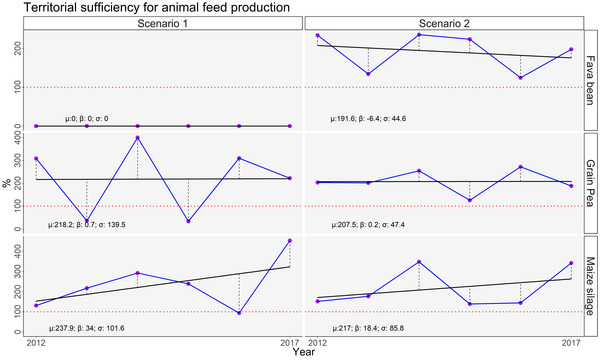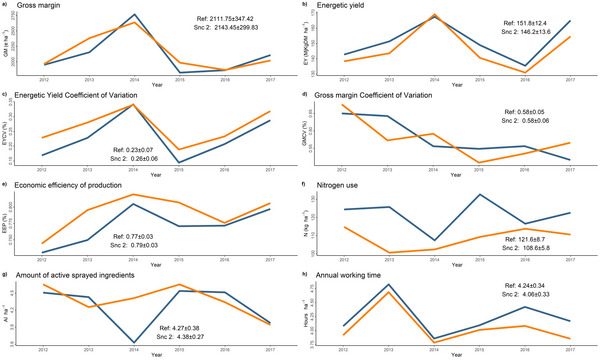Territorial crop-livestock systems are seen as a promising sustainable production model to address challenges of resource depletion and the negative impacts of agriculture, without harming farm economics.
Using MAELIA, a high-resolution multi-agent and dynamic spatial modelling framework of agricultural landscapes, we assessed the potential to increase territorial sufficiency in animal feed via legume production and economic resilience, while reducing impacts on the environment. The study focused on a motivated group of five arable farmers and two livestock farmers in Western France (Case Study 11). The livestock farmers have redesigned their animal feed in order to decrease the dependence on global markets (soya cake) through the integration of locally produced legumes (peas and fava bean), while simultaneously decreasing total feeding cost. This also provides arable farmers with a market for diversified products, including legumes.
Using MAELIA, we compared the current situation, i.e. no trade between farmers and two scenarios developed through participatory collaboration (Moraine et al., 2017): territorial complementarity (scenario 1) and territorial synergy (scenario 2). In both scenarios, arable farmers adapt their crop management to satisfy the animal feed needs of livestock farmers by introducing legumes into their rotations.
- In scenario 1, it is assumed that there is limited direct collaboration between the farmers. Hence, the original structure of crop rotations is unaltered, and legumes are strictly introduced before winter wheat and between cereals.
- In scenario 2, there is pre-established and collaborative decision-making between farmers regarding which crop rotations are chosen, and by whom, in order to fully and continuously satisfy supply and demand.
To assess the environmental and socio-economic effects of crop-livestock exchange scenarios, ten dynamic and spatially explicit indicators were selected and grouped into two dimensions: performance level and system vulnerability (Table 1). For a given indicator, low vulnerability corresponds to a combination of high values of the modelled indicator, a positive trend and an overall low variability (Martin et al., 2017).
Our results suggest that only scenario 2, based on a synergistic collaboration, allows livestock and arable farmers to achieve their objectives while improving sustainability. This strategy implied an annual conversion of 3.2 ± 4.0% (i.e., 11.2 ± 14.0 hectares) of the arable farmers’ utilised agricultural area to legumes, including specific spatial land-use coordination. On average, the arable farmers involved in the case study produced 196.9 ± 57.9 ton year-1 of fava beans and 119.4 ± 29.9 ton year-1 of peas, respectively. This completely satisfied the respective annual feed needs of the two livestock farmers (Fig.1).
Synergetic territorial crop-livestock systems would decrease the vulnerability of the system through higher (+1.5%, 31.7 euros hectare-1, Fig.2a) gross margins. This is explained by lower vegetable protein costs to feed animals (14% reduction), lower variable costs (4.2% reduction) and a global increase in the economic efficiency of production of 2.6% (Fig.2e). On average, livestock farmers improved their gross margins by 200.9 euros hectare-1 (5.41%). The gains from arable farmers were marginal (27.0 euros hectare-1, i.e., 2.0%), mainly due to the 296.9 euros hectare-1 drop of one arable farmer.
The introduction of legumes had a slightly negative effect on energy productivity (3.7%, Fig.2b), and its overall variation increased by 15.4% (Fig.2c). At the environmental level, the crop-livestock linkage led to a marginal (2.6%) increase in pesticide application (0.1 active ingredients per hectare, Fig.4g) and, as expected, caused a reduction in nitrogen applications by 13.0 nitrogen units per hectare (10.7%; Fig.4f).
Our results show that diversification through the development of exchanges between arable farmers and livestock farmers, supported by close cooperation, opens channels for a profitable and differentiated market while improving environmental performances. The combined diversification of the production processes and resources may also allow for the technical development of further agroecological practices (Havet et al., 2014). Furthermore, these results may encourage others in the vicinity to join the group, since it can make farms more resilient against financial risk and uncertainty (Lucas et al., 2019).
Yet adapting arable famers’ supply capabilities in time and space to the constant needs of livestock farmers means that well-established practices based on external inputs need to be questioned. Becoming familiar with legume management and new animal feed formulations, combined with the improvement of relationships between farmers, are therefore three areas that need to be addressed (Havet et al., 2014, Lucas et al., 2019). Farmer cooperatives, together with direct bilateral or multilateral exchanges, are two possibilities to overcome these constraints (Moraine et al., 2016a, Moraine et al., 2016b) while strengthening the social structure within the local farming community (Martin et al., 2016). These issues will be addressed in a next step within case study 11.
References
- Ryschawy, J., Moraine, M., Péquignot, M. & Martin, G. Trade-offs among individual and collective performances related to crop–livestock integration among farms: a case study in southwestern France. Org. Agric. (2018). doi:10.1007/s13165-018-0237-7
- Asai, M. et al. Critical factors for crop-livestock integration beyond the farm level: A cross-analysis of worldwide case studies. Land use policy 73, 184–194 (2018).
- Ryschawy, J., Martin, G., Moraine, M., Duru, M. & Therond, O. Designing crop–livestock integration at different levels: Toward new agroecological models? Nutr. Cycl. Agroecosystems 108, 5–20 (2017).
- Martin, G. et al. Crop–livestock integration beyond the farm level: a review. Agron. Sustain. Dev. 36, 53 (2016).
- Moraine, M., Melac, P., Ryschawy, J., Duru, M. & Therond, O. A participatory method for the design and integrated assessment of crop-livestock systems in farmers’ groups. Ecol. Indic. 72, 340–351 (2017).
- Martin, G., Magne, M.-A. & Cristobal, M. S. An Integrated Method to Analyze Farm Vulnerability to Climatic and Economic Variability According to Farm Configurations and Farmers’ Adaptations. Front. Plant Sci. 8, 1483 (2017).
- Havet, A. et al. Review of livestock farmer adaptations to increase forages in crop rotations in western France. Agric. Ecosyst. Environ. 190, 120–127 (2014).
- Lucas, V., Gasselin, P. & Ploeg, J. Local inter-farm cooperation: A hidden potential for the agroecological transition in northern agricultures. Agroecol. Sustain. Food Syst. 43, 145–179 (2019).
- Moraine, M., Duru, M. & Therond, O. A social-ecological framework for analyzing and designing integrated crop–livestock systems from farm to territory levels. Renew. Agric. Food Syst. 32, 43–56 (2016).
- Moraine, M., Grimaldi, J., Murgue, C., Duru, M. & Therond, O. Co-design and assessment of cropping systems for developing crop-livestock integration at the territory level. Agric. Syst. 147, 87–97 (2016).




 tap and then scroll down to the Add to Home Screen command.
tap and then scroll down to the Add to Home Screen command.